Leadership, Teamwork, and Performance at ASDA Report
VerifiedAdded on 2020/01/16
|14
|4564
|132
Report
AI Summary
This report analyzes leadership and management practices within ASDA, a retail-based enterprise. It covers essential leadership skills such as communication, decision-making, and motivation, differentiating them from management functions. The report compares leadership styles, specifically democratic and autocratic approaches, and discusses their application in various situations within ASDA. It examines ways to motivate staff, including effective communication, empowerment, developmental opportunities, and incentives. Furthermore, the report assesses the benefits of team-working for ASDA, evaluating team effectiveness in achieving goals, and emphasizing the importance of teamwork in leadership. Finally, it addresses the planning, monitoring, and assessment of work performance, as well as the assessment of individual development needs within ASDA.

WWLP
1
1
Paraphrase This Document
Need a fresh take? Get an instant paraphrase of this document with our AI Paraphraser
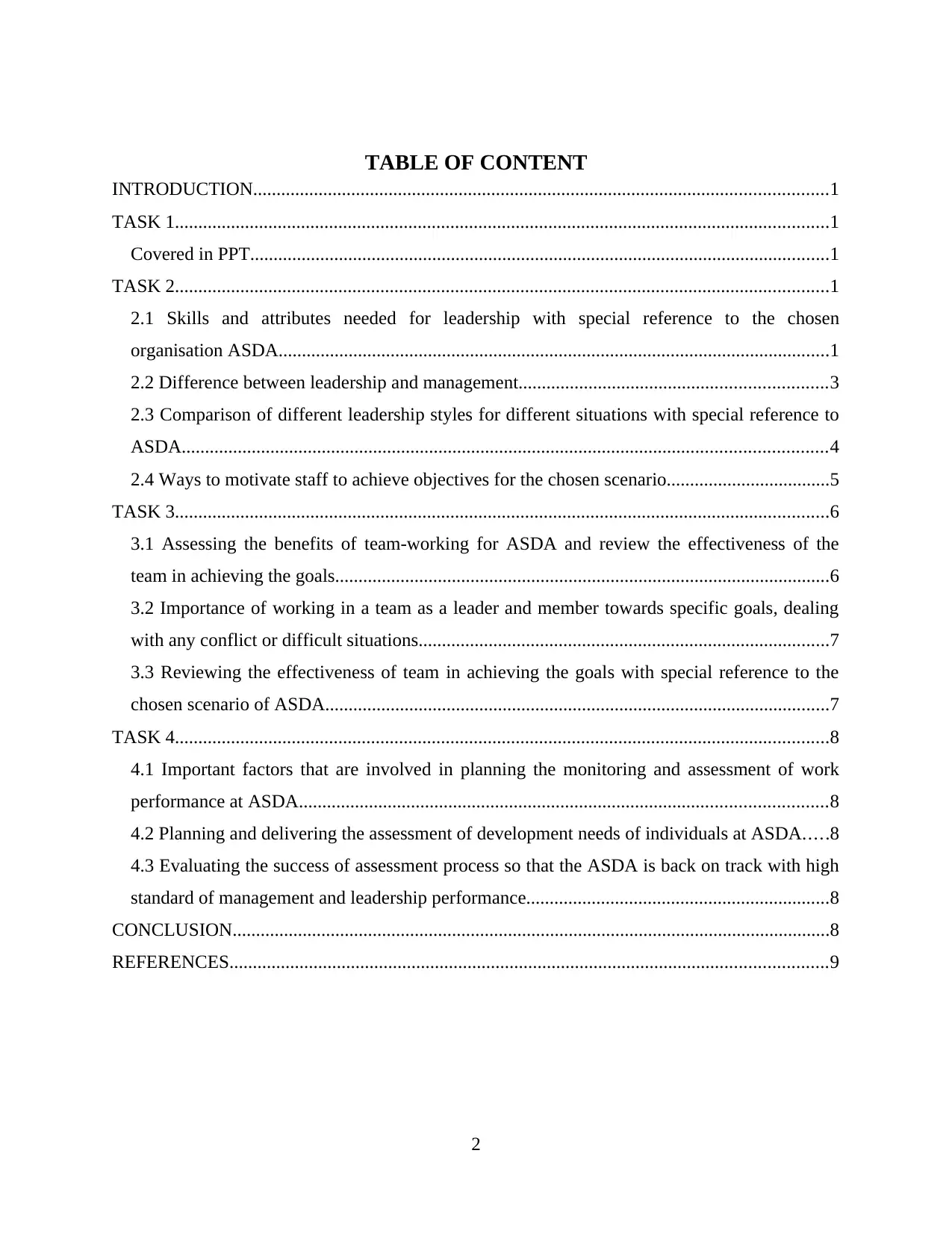
TABLE OF CONTENT
INTRODUCTION...........................................................................................................................1
TASK 1............................................................................................................................................1
Covered in PPT............................................................................................................................1
TASK 2............................................................................................................................................1
2.1 Skills and attributes needed for leadership with special reference to the chosen
organisation ASDA......................................................................................................................1
2.2 Difference between leadership and management..................................................................3
2.3 Comparison of different leadership styles for different situations with special reference to
ASDA..........................................................................................................................................4
2.4 Ways to motivate staff to achieve objectives for the chosen scenario...................................5
TASK 3............................................................................................................................................6
3.1 Assessing the benefits of team-working for ASDA and review the effectiveness of the
team in achieving the goals..........................................................................................................6
3.2 Importance of working in a team as a leader and member towards specific goals, dealing
with any conflict or difficult situations........................................................................................7
3.3 Reviewing the effectiveness of team in achieving the goals with special reference to the
chosen scenario of ASDA............................................................................................................7
TASK 4............................................................................................................................................8
4.1 Important factors that are involved in planning the monitoring and assessment of work
performance at ASDA.................................................................................................................8
4.2 Planning and delivering the assessment of development needs of individuals at ASDA.....8
4.3 Evaluating the success of assessment process so that the ASDA is back on track with high
standard of management and leadership performance.................................................................8
CONCLUSION................................................................................................................................8
REFERENCES................................................................................................................................9
2
INTRODUCTION...........................................................................................................................1
TASK 1............................................................................................................................................1
Covered in PPT............................................................................................................................1
TASK 2............................................................................................................................................1
2.1 Skills and attributes needed for leadership with special reference to the chosen
organisation ASDA......................................................................................................................1
2.2 Difference between leadership and management..................................................................3
2.3 Comparison of different leadership styles for different situations with special reference to
ASDA..........................................................................................................................................4
2.4 Ways to motivate staff to achieve objectives for the chosen scenario...................................5
TASK 3............................................................................................................................................6
3.1 Assessing the benefits of team-working for ASDA and review the effectiveness of the
team in achieving the goals..........................................................................................................6
3.2 Importance of working in a team as a leader and member towards specific goals, dealing
with any conflict or difficult situations........................................................................................7
3.3 Reviewing the effectiveness of team in achieving the goals with special reference to the
chosen scenario of ASDA............................................................................................................7
TASK 4............................................................................................................................................8
4.1 Important factors that are involved in planning the monitoring and assessment of work
performance at ASDA.................................................................................................................8
4.2 Planning and delivering the assessment of development needs of individuals at ASDA.....8
4.3 Evaluating the success of assessment process so that the ASDA is back on track with high
standard of management and leadership performance.................................................................8
CONCLUSION................................................................................................................................8
REFERENCES................................................................................................................................9
2
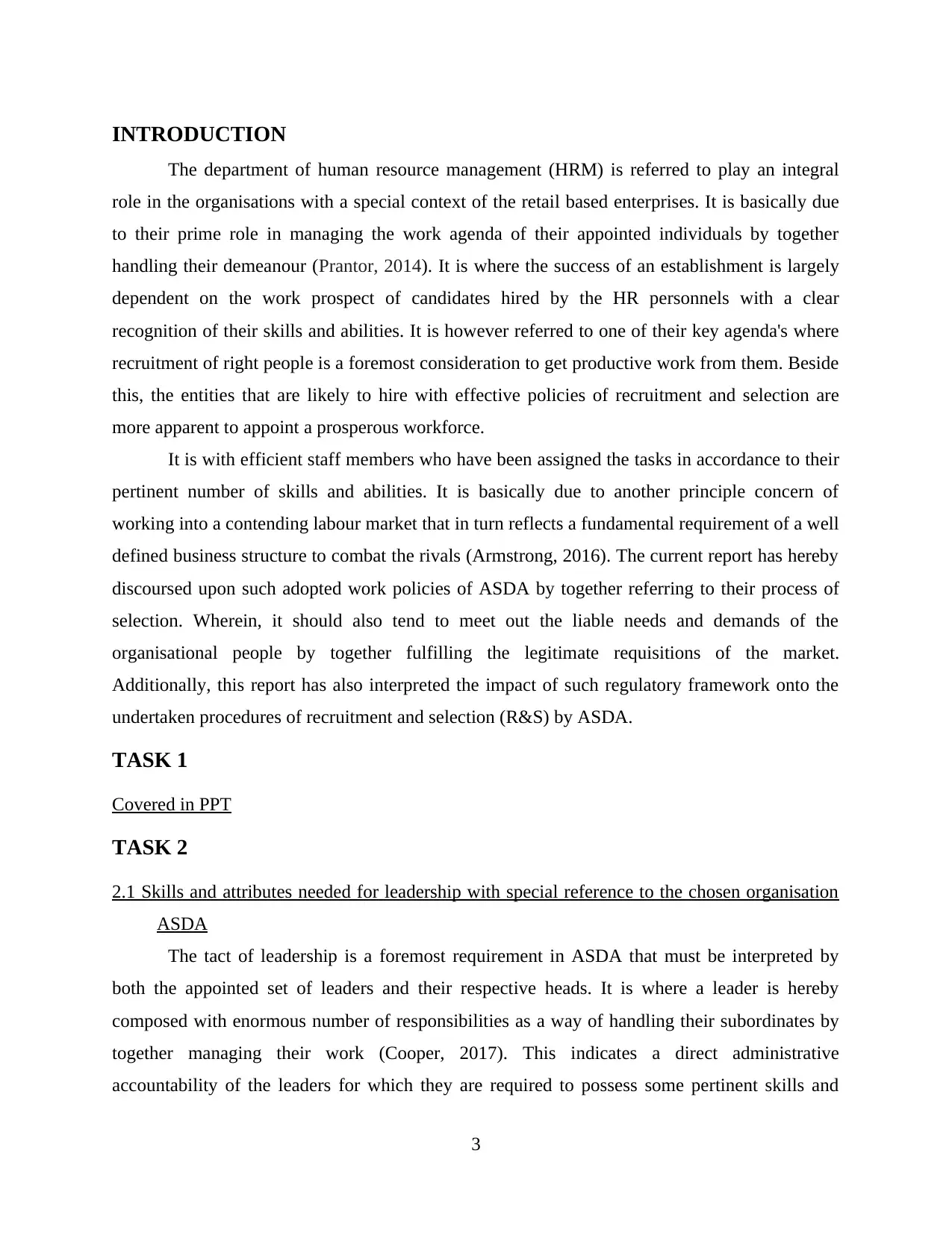
INTRODUCTION
The department of human resource management (HRM) is referred to play an integral
role in the organisations with a special context of the retail based enterprises. It is basically due
to their prime role in managing the work agenda of their appointed individuals by together
handling their demeanour (Prantor, 2014). It is where the success of an establishment is largely
dependent on the work prospect of candidates hired by the HR personnels with a clear
recognition of their skills and abilities. It is however referred to one of their key agenda's where
recruitment of right people is a foremost consideration to get productive work from them. Beside
this, the entities that are likely to hire with effective policies of recruitment and selection are
more apparent to appoint a prosperous workforce.
It is with efficient staff members who have been assigned the tasks in accordance to their
pertinent number of skills and abilities. It is basically due to another principle concern of
working into a contending labour market that in turn reflects a fundamental requirement of a well
defined business structure to combat the rivals (Armstrong, 2016). The current report has hereby
discoursed upon such adopted work policies of ASDA by together referring to their process of
selection. Wherein, it should also tend to meet out the liable needs and demands of the
organisational people by together fulfilling the legitimate requisitions of the market.
Additionally, this report has also interpreted the impact of such regulatory framework onto the
undertaken procedures of recruitment and selection (R&S) by ASDA.
TASK 1
Covered in PPT
TASK 2
2.1 Skills and attributes needed for leadership with special reference to the chosen organisation
ASDA
The tact of leadership is a foremost requirement in ASDA that must be interpreted by
both the appointed set of leaders and their respective heads. It is where a leader is hereby
composed with enormous number of responsibilities as a way of handling their subordinates by
together managing their work (Cooper, 2017). This indicates a direct administrative
accountability of the leaders for which they are required to possess some pertinent skills and
3
The department of human resource management (HRM) is referred to play an integral
role in the organisations with a special context of the retail based enterprises. It is basically due
to their prime role in managing the work agenda of their appointed individuals by together
handling their demeanour (Prantor, 2014). It is where the success of an establishment is largely
dependent on the work prospect of candidates hired by the HR personnels with a clear
recognition of their skills and abilities. It is however referred to one of their key agenda's where
recruitment of right people is a foremost consideration to get productive work from them. Beside
this, the entities that are likely to hire with effective policies of recruitment and selection are
more apparent to appoint a prosperous workforce.
It is with efficient staff members who have been assigned the tasks in accordance to their
pertinent number of skills and abilities. It is basically due to another principle concern of
working into a contending labour market that in turn reflects a fundamental requirement of a well
defined business structure to combat the rivals (Armstrong, 2016). The current report has hereby
discoursed upon such adopted work policies of ASDA by together referring to their process of
selection. Wherein, it should also tend to meet out the liable needs and demands of the
organisational people by together fulfilling the legitimate requisitions of the market.
Additionally, this report has also interpreted the impact of such regulatory framework onto the
undertaken procedures of recruitment and selection (R&S) by ASDA.
TASK 1
Covered in PPT
TASK 2
2.1 Skills and attributes needed for leadership with special reference to the chosen organisation
ASDA
The tact of leadership is a foremost requirement in ASDA that must be interpreted by
both the appointed set of leaders and their respective heads. It is where a leader is hereby
composed with enormous number of responsibilities as a way of handling their subordinates by
together managing their work (Cooper, 2017). This indicates a direct administrative
accountability of the leaders for which they are required to possess some pertinent skills and
3
⊘ This is a preview!⊘
Do you want full access?
Subscribe today to unlock all pages.

Trusted by 1+ million students worldwide
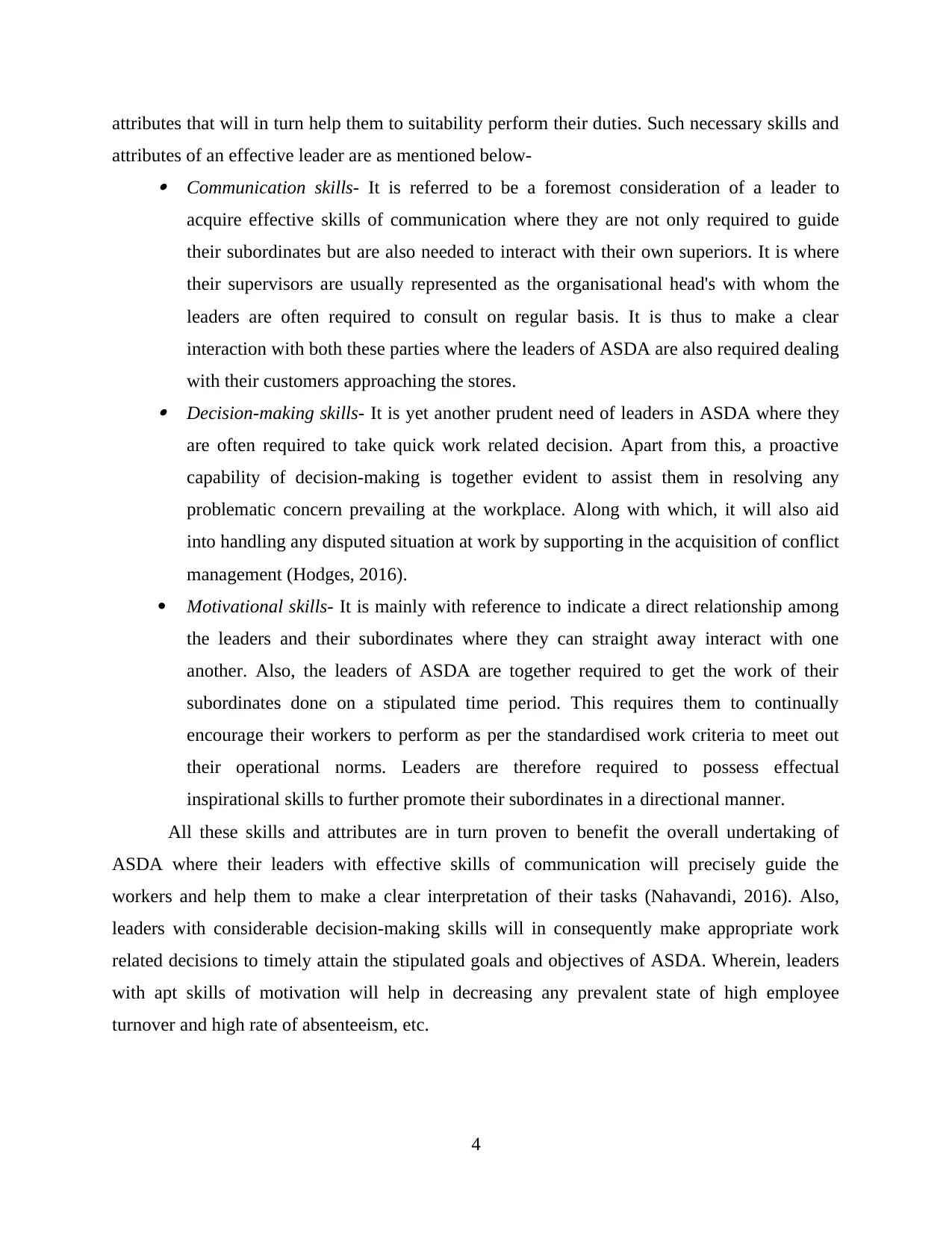
attributes that will in turn help them to suitability perform their duties. Such necessary skills and
attributes of an effective leader are as mentioned below-
Communication skills- It is referred to be a foremost consideration of a leader to
acquire effective skills of communication where they are not only required to guide
their subordinates but are also needed to interact with their own superiors. It is where
their supervisors are usually represented as the organisational head's with whom the
leaders are often required to consult on regular basis. It is thus to make a clear
interaction with both these parties where the leaders of ASDA are also required dealing
with their customers approaching the stores.
Decision-making skills- It is yet another prudent need of leaders in ASDA where they
are often required to take quick work related decision. Apart from this, a proactive
capability of decision-making is together evident to assist them in resolving any
problematic concern prevailing at the workplace. Along with which, it will also aid
into handling any disputed situation at work by supporting in the acquisition of conflict
management (Hodges, 2016).
Motivational skills- It is mainly with reference to indicate a direct relationship among
the leaders and their subordinates where they can straight away interact with one
another. Also, the leaders of ASDA are together required to get the work of their
subordinates done on a stipulated time period. This requires them to continually
encourage their workers to perform as per the standardised work criteria to meet out
their operational norms. Leaders are therefore required to possess effectual
inspirational skills to further promote their subordinates in a directional manner.
All these skills and attributes are in turn proven to benefit the overall undertaking of
ASDA where their leaders with effective skills of communication will precisely guide the
workers and help them to make a clear interpretation of their tasks (Nahavandi, 2016). Also,
leaders with considerable decision-making skills will in consequently make appropriate work
related decisions to timely attain the stipulated goals and objectives of ASDA. Wherein, leaders
with apt skills of motivation will help in decreasing any prevalent state of high employee
turnover and high rate of absenteeism, etc.
4
attributes of an effective leader are as mentioned below-
Communication skills- It is referred to be a foremost consideration of a leader to
acquire effective skills of communication where they are not only required to guide
their subordinates but are also needed to interact with their own superiors. It is where
their supervisors are usually represented as the organisational head's with whom the
leaders are often required to consult on regular basis. It is thus to make a clear
interaction with both these parties where the leaders of ASDA are also required dealing
with their customers approaching the stores.
Decision-making skills- It is yet another prudent need of leaders in ASDA where they
are often required to take quick work related decision. Apart from this, a proactive
capability of decision-making is together evident to assist them in resolving any
problematic concern prevailing at the workplace. Along with which, it will also aid
into handling any disputed situation at work by supporting in the acquisition of conflict
management (Hodges, 2016).
Motivational skills- It is mainly with reference to indicate a direct relationship among
the leaders and their subordinates where they can straight away interact with one
another. Also, the leaders of ASDA are together required to get the work of their
subordinates done on a stipulated time period. This requires them to continually
encourage their workers to perform as per the standardised work criteria to meet out
their operational norms. Leaders are therefore required to possess effectual
inspirational skills to further promote their subordinates in a directional manner.
All these skills and attributes are in turn proven to benefit the overall undertaking of
ASDA where their leaders with effective skills of communication will precisely guide the
workers and help them to make a clear interpretation of their tasks (Nahavandi, 2016). Also,
leaders with considerable decision-making skills will in consequently make appropriate work
related decisions to timely attain the stipulated goals and objectives of ASDA. Wherein, leaders
with apt skills of motivation will help in decreasing any prevalent state of high employee
turnover and high rate of absenteeism, etc.
4
Paraphrase This Document
Need a fresh take? Get an instant paraphrase of this document with our AI Paraphraser
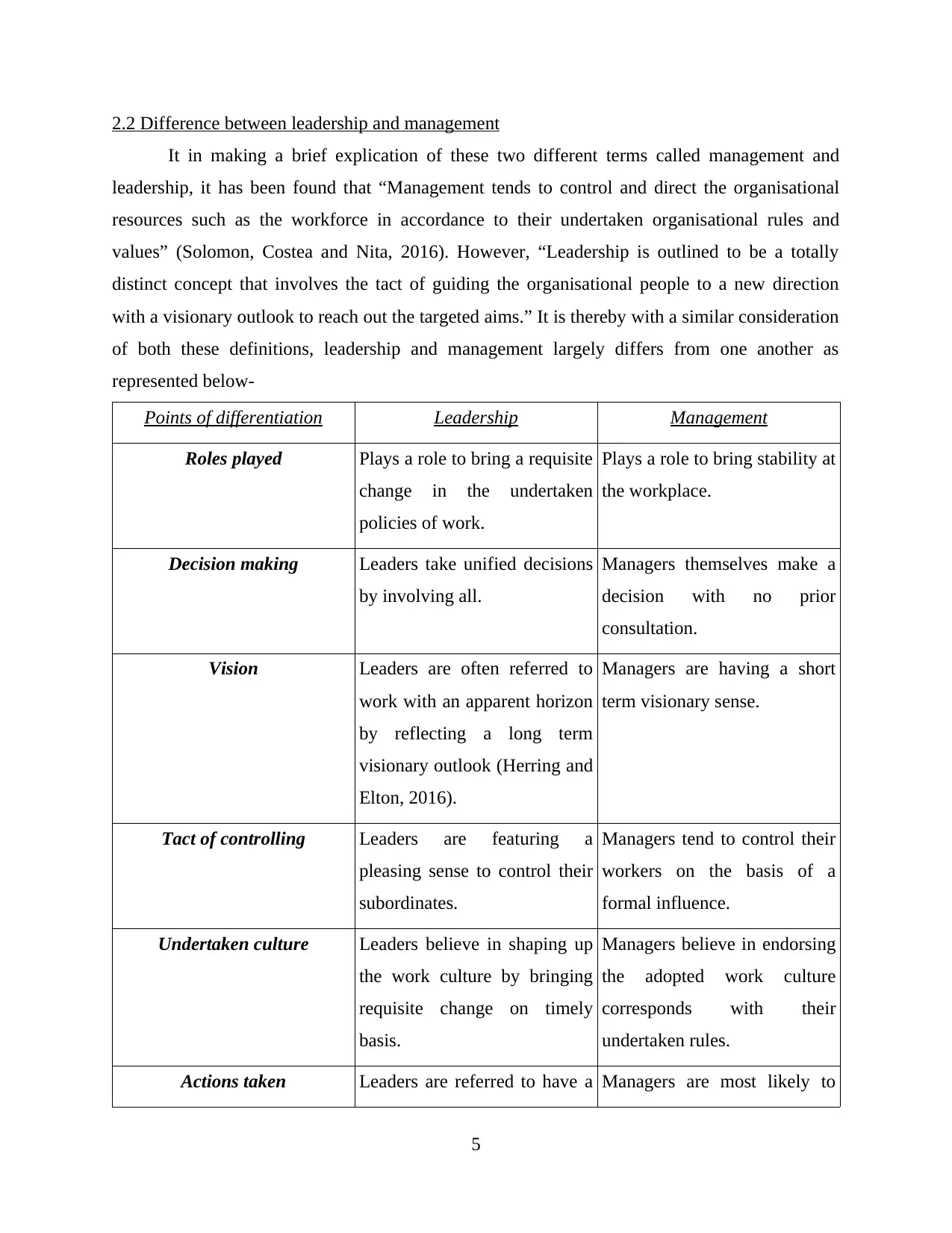
2.2 Difference between leadership and management
It in making a brief explication of these two different terms called management and
leadership, it has been found that “Management tends to control and direct the organisational
resources such as the workforce in accordance to their undertaken organisational rules and
values” (Solomon, Costea and Nita, 2016). However, “Leadership is outlined to be a totally
distinct concept that involves the tact of guiding the organisational people to a new direction
with a visionary outlook to reach out the targeted aims.” It is thereby with a similar consideration
of both these definitions, leadership and management largely differs from one another as
represented below-
Points of differentiation Leadership Management
Roles played Plays a role to bring a requisite
change in the undertaken
policies of work.
Plays a role to bring stability at
the workplace.
Decision making Leaders take unified decisions
by involving all.
Managers themselves make a
decision with no prior
consultation.
Vision Leaders are often referred to
work with an apparent horizon
by reflecting a long term
visionary outlook (Herring and
Elton, 2016).
Managers are having a short
term visionary sense.
Tact of controlling Leaders are featuring a
pleasing sense to control their
subordinates.
Managers tend to control their
workers on the basis of a
formal influence.
Undertaken culture Leaders believe in shaping up
the work culture by bringing
requisite change on timely
basis.
Managers believe in endorsing
the adopted work culture
corresponds with their
undertaken rules.
Actions taken Leaders are referred to have a Managers are most likely to
5
It in making a brief explication of these two different terms called management and
leadership, it has been found that “Management tends to control and direct the organisational
resources such as the workforce in accordance to their undertaken organisational rules and
values” (Solomon, Costea and Nita, 2016). However, “Leadership is outlined to be a totally
distinct concept that involves the tact of guiding the organisational people to a new direction
with a visionary outlook to reach out the targeted aims.” It is thereby with a similar consideration
of both these definitions, leadership and management largely differs from one another as
represented below-
Points of differentiation Leadership Management
Roles played Plays a role to bring a requisite
change in the undertaken
policies of work.
Plays a role to bring stability at
the workplace.
Decision making Leaders take unified decisions
by involving all.
Managers themselves make a
decision with no prior
consultation.
Vision Leaders are often referred to
work with an apparent horizon
by reflecting a long term
visionary outlook (Herring and
Elton, 2016).
Managers are having a short
term visionary sense.
Tact of controlling Leaders are featuring a
pleasing sense to control their
subordinates.
Managers tend to control their
workers on the basis of a
formal influence.
Undertaken culture Leaders believe in shaping up
the work culture by bringing
requisite change on timely
basis.
Managers believe in endorsing
the adopted work culture
corresponds with their
undertaken rules.
Actions taken Leaders are referred to have a Managers are most likely to
5
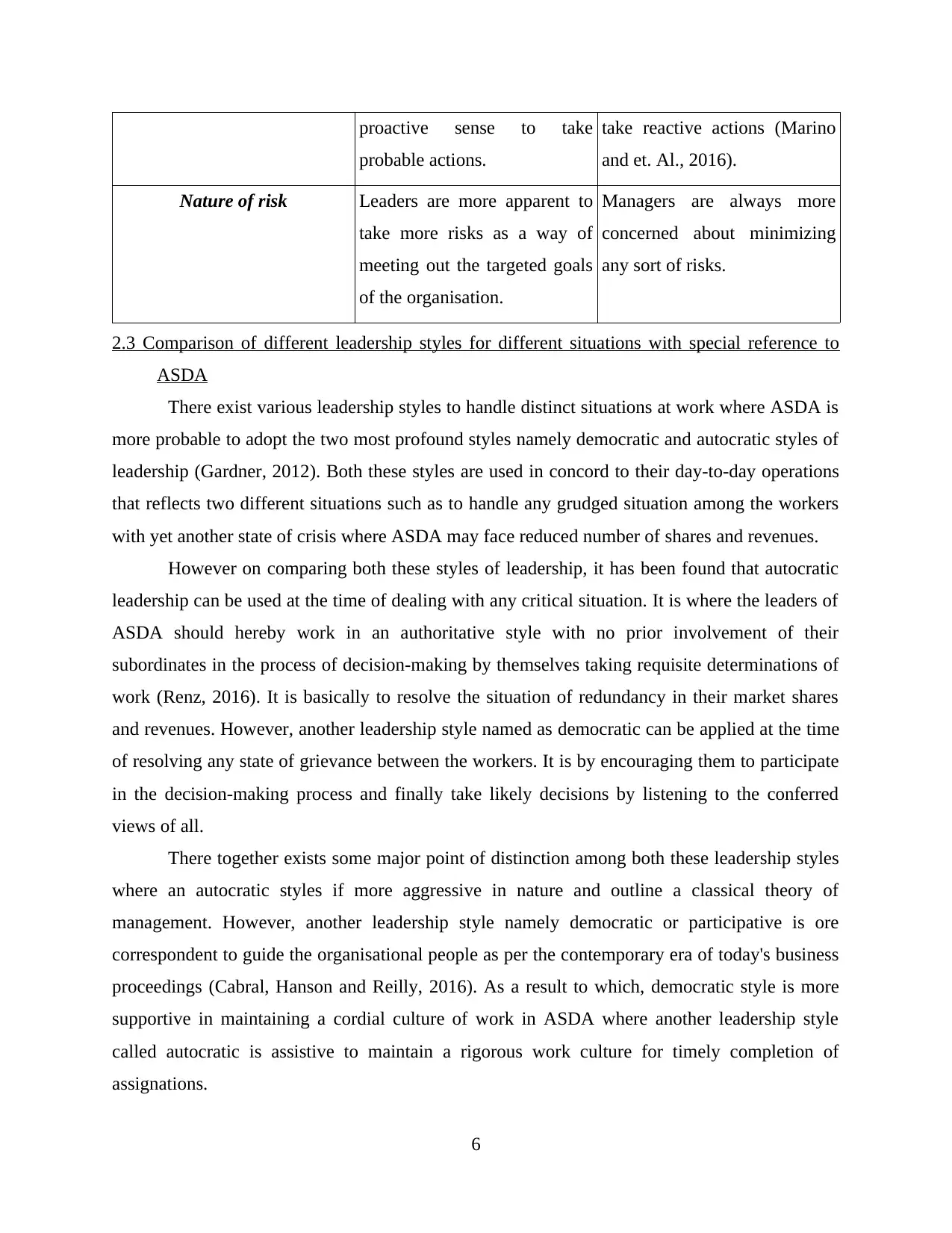
proactive sense to take
probable actions.
take reactive actions (Marino
and et. Al., 2016).
Nature of risk Leaders are more apparent to
take more risks as a way of
meeting out the targeted goals
of the organisation.
Managers are always more
concerned about minimizing
any sort of risks.
2.3 Comparison of different leadership styles for different situations with special reference to
ASDA
There exist various leadership styles to handle distinct situations at work where ASDA is
more probable to adopt the two most profound styles namely democratic and autocratic styles of
leadership (Gardner, 2012). Both these styles are used in concord to their day-to-day operations
that reflects two different situations such as to handle any grudged situation among the workers
with yet another state of crisis where ASDA may face reduced number of shares and revenues.
However on comparing both these styles of leadership, it has been found that autocratic
leadership can be used at the time of dealing with any critical situation. It is where the leaders of
ASDA should hereby work in an authoritative style with no prior involvement of their
subordinates in the process of decision-making by themselves taking requisite determinations of
work (Renz, 2016). It is basically to resolve the situation of redundancy in their market shares
and revenues. However, another leadership style named as democratic can be applied at the time
of resolving any state of grievance between the workers. It is by encouraging them to participate
in the decision-making process and finally take likely decisions by listening to the conferred
views of all.
There together exists some major point of distinction among both these leadership styles
where an autocratic styles if more aggressive in nature and outline a classical theory of
management. However, another leadership style namely democratic or participative is ore
correspondent to guide the organisational people as per the contemporary era of today's business
proceedings (Cabral, Hanson and Reilly, 2016). As a result to which, democratic style is more
supportive in maintaining a cordial culture of work in ASDA where another leadership style
called autocratic is assistive to maintain a rigorous work culture for timely completion of
assignations.
6
probable actions.
take reactive actions (Marino
and et. Al., 2016).
Nature of risk Leaders are more apparent to
take more risks as a way of
meeting out the targeted goals
of the organisation.
Managers are always more
concerned about minimizing
any sort of risks.
2.3 Comparison of different leadership styles for different situations with special reference to
ASDA
There exist various leadership styles to handle distinct situations at work where ASDA is
more probable to adopt the two most profound styles namely democratic and autocratic styles of
leadership (Gardner, 2012). Both these styles are used in concord to their day-to-day operations
that reflects two different situations such as to handle any grudged situation among the workers
with yet another state of crisis where ASDA may face reduced number of shares and revenues.
However on comparing both these styles of leadership, it has been found that autocratic
leadership can be used at the time of dealing with any critical situation. It is where the leaders of
ASDA should hereby work in an authoritative style with no prior involvement of their
subordinates in the process of decision-making by themselves taking requisite determinations of
work (Renz, 2016). It is basically to resolve the situation of redundancy in their market shares
and revenues. However, another leadership style named as democratic can be applied at the time
of resolving any state of grievance between the workers. It is by encouraging them to participate
in the decision-making process and finally take likely decisions by listening to the conferred
views of all.
There together exists some major point of distinction among both these leadership styles
where an autocratic styles if more aggressive in nature and outline a classical theory of
management. However, another leadership style namely democratic or participative is ore
correspondent to guide the organisational people as per the contemporary era of today's business
proceedings (Cabral, Hanson and Reilly, 2016). As a result to which, democratic style is more
supportive in maintaining a cordial culture of work in ASDA where another leadership style
called autocratic is assistive to maintain a rigorous work culture for timely completion of
assignations.
6
⊘ This is a preview!⊘
Do you want full access?
Subscribe today to unlock all pages.

Trusted by 1+ million students worldwide
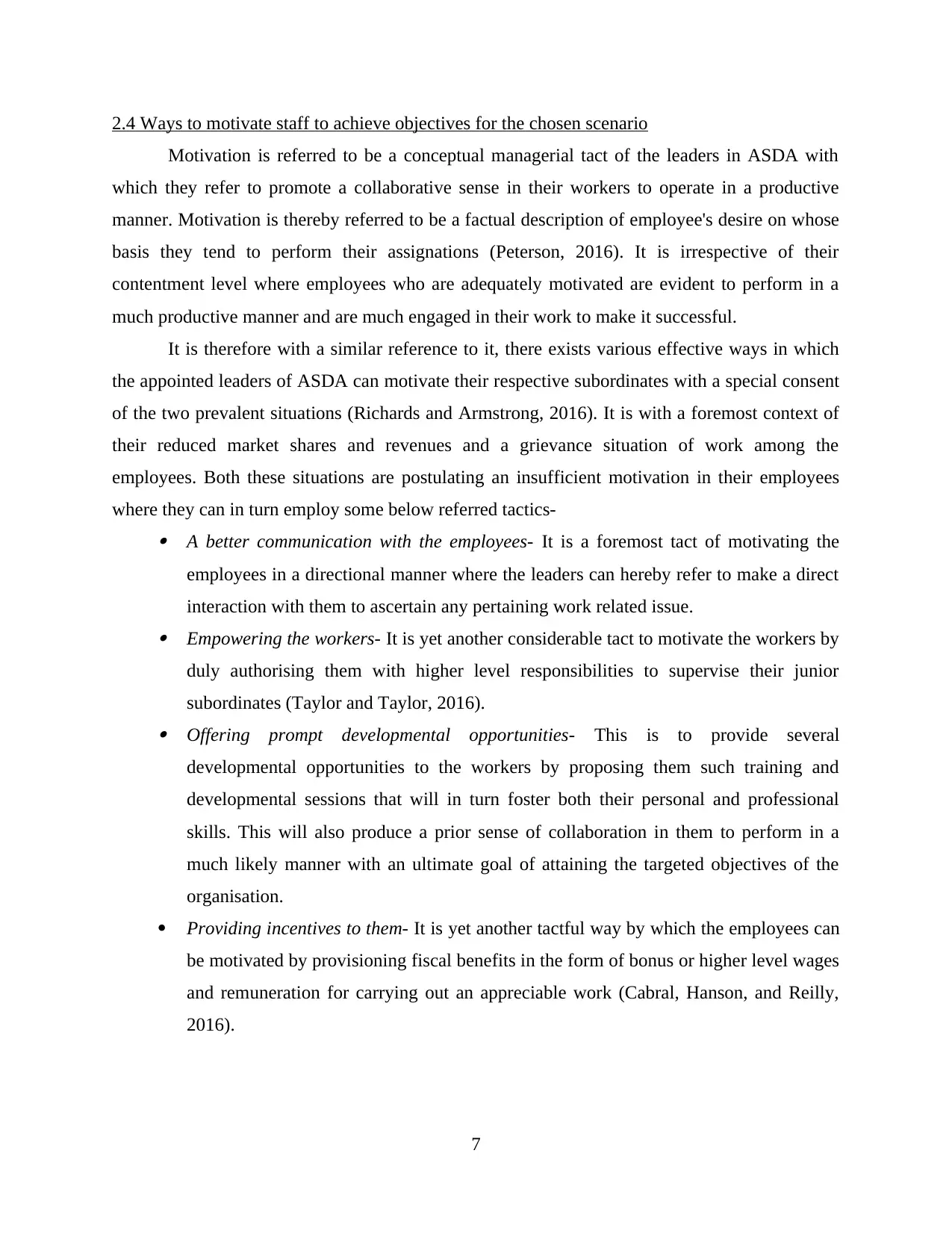
2.4 Ways to motivate staff to achieve objectives for the chosen scenario
Motivation is referred to be a conceptual managerial tact of the leaders in ASDA with
which they refer to promote a collaborative sense in their workers to operate in a productive
manner. Motivation is thereby referred to be a factual description of employee's desire on whose
basis they tend to perform their assignations (Peterson, 2016). It is irrespective of their
contentment level where employees who are adequately motivated are evident to perform in a
much productive manner and are much engaged in their work to make it successful.
It is therefore with a similar reference to it, there exists various effective ways in which
the appointed leaders of ASDA can motivate their respective subordinates with a special consent
of the two prevalent situations (Richards and Armstrong, 2016). It is with a foremost context of
their reduced market shares and revenues and a grievance situation of work among the
employees. Both these situations are postulating an insufficient motivation in their employees
where they can in turn employ some below referred tactics-
A better communication with the employees- It is a foremost tact of motivating the
employees in a directional manner where the leaders can hereby refer to make a direct
interaction with them to ascertain any pertaining work related issue.
Empowering the workers- It is yet another considerable tact to motivate the workers by
duly authorising them with higher level responsibilities to supervise their junior
subordinates (Taylor and Taylor, 2016).
Offering prompt developmental opportunities- This is to provide several
developmental opportunities to the workers by proposing them such training and
developmental sessions that will in turn foster both their personal and professional
skills. This will also produce a prior sense of collaboration in them to perform in a
much likely manner with an ultimate goal of attaining the targeted objectives of the
organisation.
Providing incentives to them- It is yet another tactful way by which the employees can
be motivated by provisioning fiscal benefits in the form of bonus or higher level wages
and remuneration for carrying out an appreciable work (Cabral, Hanson, and Reilly,
2016).
7
Motivation is referred to be a conceptual managerial tact of the leaders in ASDA with
which they refer to promote a collaborative sense in their workers to operate in a productive
manner. Motivation is thereby referred to be a factual description of employee's desire on whose
basis they tend to perform their assignations (Peterson, 2016). It is irrespective of their
contentment level where employees who are adequately motivated are evident to perform in a
much productive manner and are much engaged in their work to make it successful.
It is therefore with a similar reference to it, there exists various effective ways in which
the appointed leaders of ASDA can motivate their respective subordinates with a special consent
of the two prevalent situations (Richards and Armstrong, 2016). It is with a foremost context of
their reduced market shares and revenues and a grievance situation of work among the
employees. Both these situations are postulating an insufficient motivation in their employees
where they can in turn employ some below referred tactics-
A better communication with the employees- It is a foremost tact of motivating the
employees in a directional manner where the leaders can hereby refer to make a direct
interaction with them to ascertain any pertaining work related issue.
Empowering the workers- It is yet another considerable tact to motivate the workers by
duly authorising them with higher level responsibilities to supervise their junior
subordinates (Taylor and Taylor, 2016).
Offering prompt developmental opportunities- This is to provide several
developmental opportunities to the workers by proposing them such training and
developmental sessions that will in turn foster both their personal and professional
skills. This will also produce a prior sense of collaboration in them to perform in a
much likely manner with an ultimate goal of attaining the targeted objectives of the
organisation.
Providing incentives to them- It is yet another tactful way by which the employees can
be motivated by provisioning fiscal benefits in the form of bonus or higher level wages
and remuneration for carrying out an appreciable work (Cabral, Hanson, and Reilly,
2016).
7
Paraphrase This Document
Need a fresh take? Get an instant paraphrase of this document with our AI Paraphraser

TASK 3
3.1 Assessing the benefits of team-working for ASDA and review the effectiveness of the team
in achieving the goals
It is on discoursing upon the concept of team work that is referred to be a prompt
requirement of today’s modern day business set ups. It is basically a group work in which more
than one or two individuals tends to operate together in order to accomplish an assigned task
(Herring and Elton, 2016). Team work is however composed of certain advantages and
drawbacks where the benefits of team work in ASDA are as discoursed below- An improved morale of individuals- It is where the individuals working in group are more
likely to operate with a greater sense of collaboration with a confident outlook to take
prompt work related decisions. A reinforced learning along with a fostered creativity- It is yet another beneficial tact of
team work that duly strengthens the thinking ability of the group members by together
raising their creativeness (Renz, 2016). This in turn depicts an elevated efficiency in them
from which they generates better ideas.
Wherein, there together exist some vital challenges to work in a team in ASDA, as referred
below- A lacking trust- Team work is a distressed consideration when the group mates do no
refer to believe on one other that in turn leads to an inadequate transparency among them.
It is hence important for the superior bodies of ASDA to form such a team whose
individuals are supportive in nature and thus understands one other.
A disputed work environment- This is yet another challenging phase of team work in
which there exist some sort of conflict among the team mates either before or after the
formation of their group (Prantor, 2014). As a result to which, it becomes impossible for
them to work together in a team and further creates problems and misunderstandings
between them.
Herein, in case the HRM personnel’s of ASDA effectively handles any such disputed
surrounds at work by applying efficient policies, then team work is referred to bring out
advantageous outcomes. However, the group members are hereby required to motivate their
workers on continual basis by together arranging timely sessions of training and development to
them.
8
3.1 Assessing the benefits of team-working for ASDA and review the effectiveness of the team
in achieving the goals
It is on discoursing upon the concept of team work that is referred to be a prompt
requirement of today’s modern day business set ups. It is basically a group work in which more
than one or two individuals tends to operate together in order to accomplish an assigned task
(Herring and Elton, 2016). Team work is however composed of certain advantages and
drawbacks where the benefits of team work in ASDA are as discoursed below- An improved morale of individuals- It is where the individuals working in group are more
likely to operate with a greater sense of collaboration with a confident outlook to take
prompt work related decisions. A reinforced learning along with a fostered creativity- It is yet another beneficial tact of
team work that duly strengthens the thinking ability of the group members by together
raising their creativeness (Renz, 2016). This in turn depicts an elevated efficiency in them
from which they generates better ideas.
Wherein, there together exist some vital challenges to work in a team in ASDA, as referred
below- A lacking trust- Team work is a distressed consideration when the group mates do no
refer to believe on one other that in turn leads to an inadequate transparency among them.
It is hence important for the superior bodies of ASDA to form such a team whose
individuals are supportive in nature and thus understands one other.
A disputed work environment- This is yet another challenging phase of team work in
which there exist some sort of conflict among the team mates either before or after the
formation of their group (Prantor, 2014). As a result to which, it becomes impossible for
them to work together in a team and further creates problems and misunderstandings
between them.
Herein, in case the HRM personnel’s of ASDA effectively handles any such disputed
surrounds at work by applying efficient policies, then team work is referred to bring out
advantageous outcomes. However, the group members are hereby required to motivate their
workers on continual basis by together arranging timely sessions of training and development to
them.
8
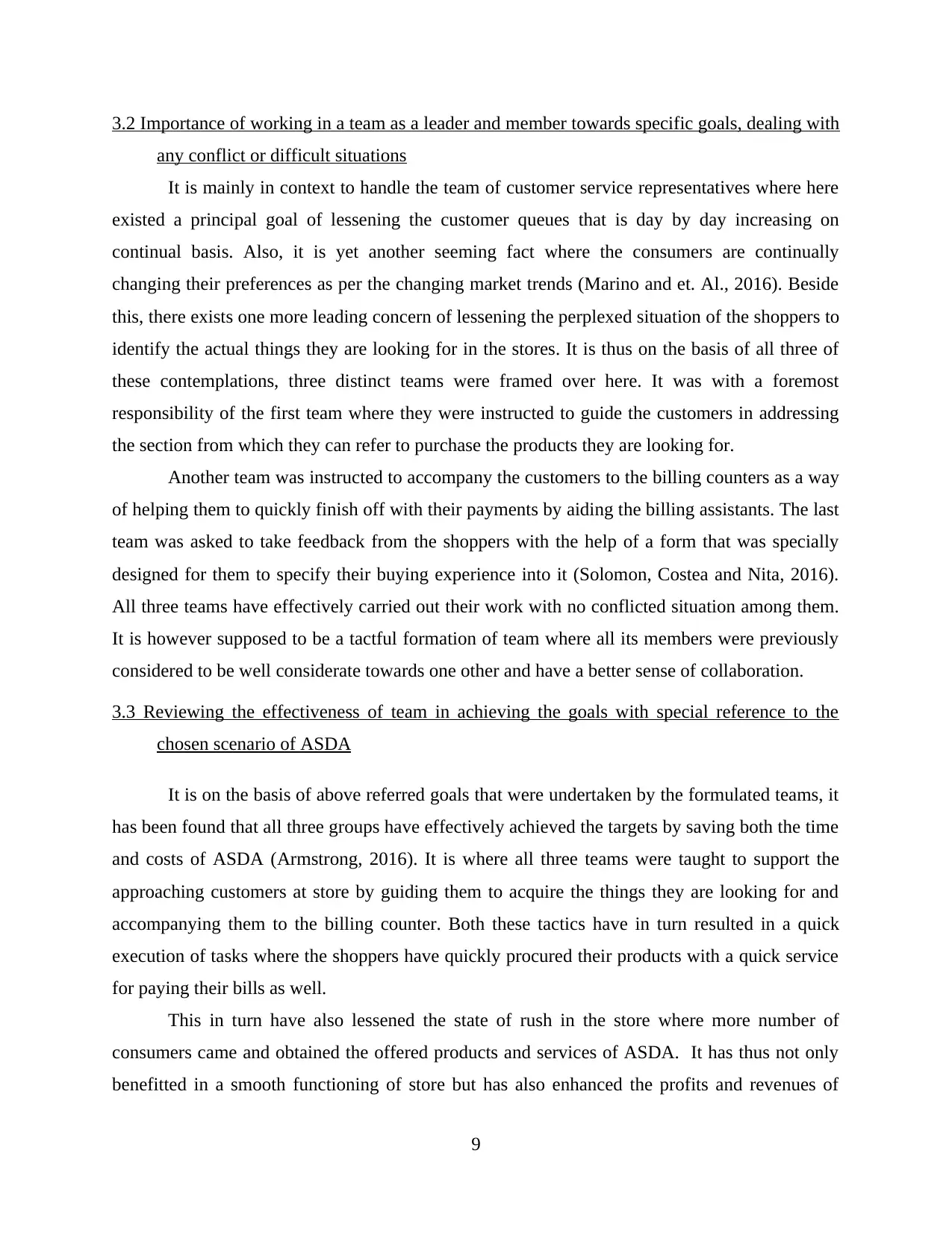
3.2 Importance of working in a team as a leader and member towards specific goals, dealing with
any conflict or difficult situations
It is mainly in context to handle the team of customer service representatives where here
existed a principal goal of lessening the customer queues that is day by day increasing on
continual basis. Also, it is yet another seeming fact where the consumers are continually
changing their preferences as per the changing market trends (Marino and et. Al., 2016). Beside
this, there exists one more leading concern of lessening the perplexed situation of the shoppers to
identify the actual things they are looking for in the stores. It is thus on the basis of all three of
these contemplations, three distinct teams were framed over here. It was with a foremost
responsibility of the first team where they were instructed to guide the customers in addressing
the section from which they can refer to purchase the products they are looking for.
Another team was instructed to accompany the customers to the billing counters as a way
of helping them to quickly finish off with their payments by aiding the billing assistants. The last
team was asked to take feedback from the shoppers with the help of a form that was specially
designed for them to specify their buying experience into it (Solomon, Costea and Nita, 2016).
All three teams have effectively carried out their work with no conflicted situation among them.
It is however supposed to be a tactful formation of team where all its members were previously
considered to be well considerate towards one other and have a better sense of collaboration.
3.3 Reviewing the effectiveness of team in achieving the goals with special reference to the
chosen scenario of ASDA
It is on the basis of above referred goals that were undertaken by the formulated teams, it
has been found that all three groups have effectively achieved the targets by saving both the time
and costs of ASDA (Armstrong, 2016). It is where all three teams were taught to support the
approaching customers at store by guiding them to acquire the things they are looking for and
accompanying them to the billing counter. Both these tactics have in turn resulted in a quick
execution of tasks where the shoppers have quickly procured their products with a quick service
for paying their bills as well.
This in turn have also lessened the state of rush in the store where more number of
consumers came and obtained the offered products and services of ASDA. It has thus not only
benefitted in a smooth functioning of store but has also enhanced the profits and revenues of
9
any conflict or difficult situations
It is mainly in context to handle the team of customer service representatives where here
existed a principal goal of lessening the customer queues that is day by day increasing on
continual basis. Also, it is yet another seeming fact where the consumers are continually
changing their preferences as per the changing market trends (Marino and et. Al., 2016). Beside
this, there exists one more leading concern of lessening the perplexed situation of the shoppers to
identify the actual things they are looking for in the stores. It is thus on the basis of all three of
these contemplations, three distinct teams were framed over here. It was with a foremost
responsibility of the first team where they were instructed to guide the customers in addressing
the section from which they can refer to purchase the products they are looking for.
Another team was instructed to accompany the customers to the billing counters as a way
of helping them to quickly finish off with their payments by aiding the billing assistants. The last
team was asked to take feedback from the shoppers with the help of a form that was specially
designed for them to specify their buying experience into it (Solomon, Costea and Nita, 2016).
All three teams have effectively carried out their work with no conflicted situation among them.
It is however supposed to be a tactful formation of team where all its members were previously
considered to be well considerate towards one other and have a better sense of collaboration.
3.3 Reviewing the effectiveness of team in achieving the goals with special reference to the
chosen scenario of ASDA
It is on the basis of above referred goals that were undertaken by the formulated teams, it
has been found that all three groups have effectively achieved the targets by saving both the time
and costs of ASDA (Armstrong, 2016). It is where all three teams were taught to support the
approaching customers at store by guiding them to acquire the things they are looking for and
accompanying them to the billing counter. Both these tactics have in turn resulted in a quick
execution of tasks where the shoppers have quickly procured their products with a quick service
for paying their bills as well.
This in turn have also lessened the state of rush in the store where more number of
consumers came and obtained the offered products and services of ASDA. It has thus not only
benefitted in a smooth functioning of store but has also enhanced the profits and revenues of
9
⊘ This is a preview!⊘
Do you want full access?
Subscribe today to unlock all pages.

Trusted by 1+ million students worldwide
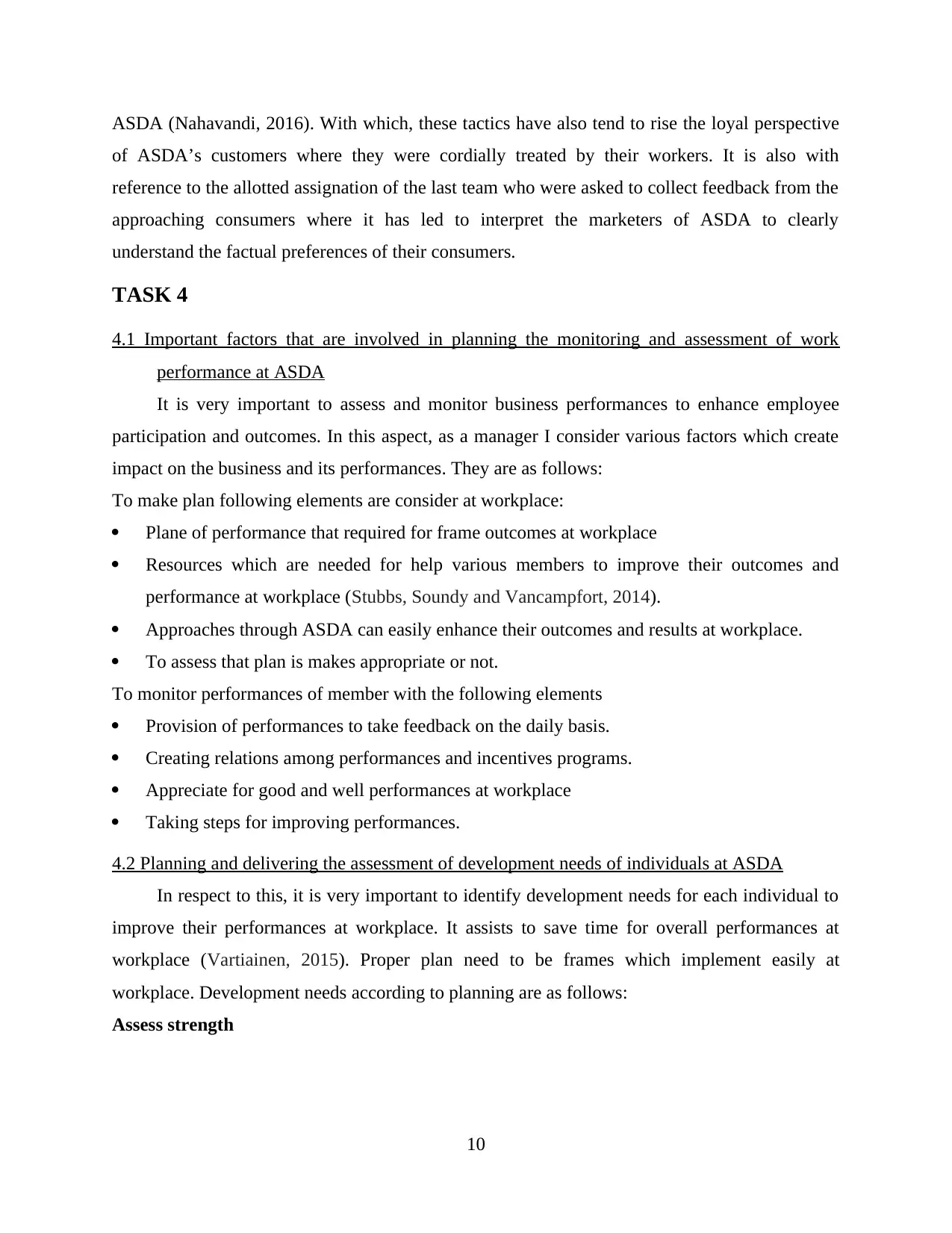
ASDA (Nahavandi, 2016). With which, these tactics have also tend to rise the loyal perspective
of ASDA’s customers where they were cordially treated by their workers. It is also with
reference to the allotted assignation of the last team who were asked to collect feedback from the
approaching consumers where it has led to interpret the marketers of ASDA to clearly
understand the factual preferences of their consumers.
TASK 4
4.1 Important factors that are involved in planning the monitoring and assessment of work
performance at ASDA
It is very important to assess and monitor business performances to enhance employee
participation and outcomes. In this aspect, as a manager I consider various factors which create
impact on the business and its performances. They are as follows:
To make plan following elements are consider at workplace:
Plane of performance that required for frame outcomes at workplace
Resources which are needed for help various members to improve their outcomes and
performance at workplace (Stubbs, Soundy and Vancampfort, 2014).
Approaches through ASDA can easily enhance their outcomes and results at workplace.
To assess that plan is makes appropriate or not.
To monitor performances of member with the following elements
Provision of performances to take feedback on the daily basis.
Creating relations among performances and incentives programs.
Appreciate for good and well performances at workplace
Taking steps for improving performances.
4.2 Planning and delivering the assessment of development needs of individuals at ASDA
In respect to this, it is very important to identify development needs for each individual to
improve their performances at workplace. It assists to save time for overall performances at
workplace (Vartiainen, 2015). Proper plan need to be frames which implement easily at
workplace. Development needs according to planning are as follows:
Assess strength
10
of ASDA’s customers where they were cordially treated by their workers. It is also with
reference to the allotted assignation of the last team who were asked to collect feedback from the
approaching consumers where it has led to interpret the marketers of ASDA to clearly
understand the factual preferences of their consumers.
TASK 4
4.1 Important factors that are involved in planning the monitoring and assessment of work
performance at ASDA
It is very important to assess and monitor business performances to enhance employee
participation and outcomes. In this aspect, as a manager I consider various factors which create
impact on the business and its performances. They are as follows:
To make plan following elements are consider at workplace:
Plane of performance that required for frame outcomes at workplace
Resources which are needed for help various members to improve their outcomes and
performance at workplace (Stubbs, Soundy and Vancampfort, 2014).
Approaches through ASDA can easily enhance their outcomes and results at workplace.
To assess that plan is makes appropriate or not.
To monitor performances of member with the following elements
Provision of performances to take feedback on the daily basis.
Creating relations among performances and incentives programs.
Appreciate for good and well performances at workplace
Taking steps for improving performances.
4.2 Planning and delivering the assessment of development needs of individuals at ASDA
In respect to this, it is very important to identify development needs for each individual to
improve their performances at workplace. It assists to save time for overall performances at
workplace (Vartiainen, 2015). Proper plan need to be frames which implement easily at
workplace. Development needs according to planning are as follows:
Assess strength
10
Paraphrase This Document
Need a fresh take? Get an instant paraphrase of this document with our AI Paraphraser
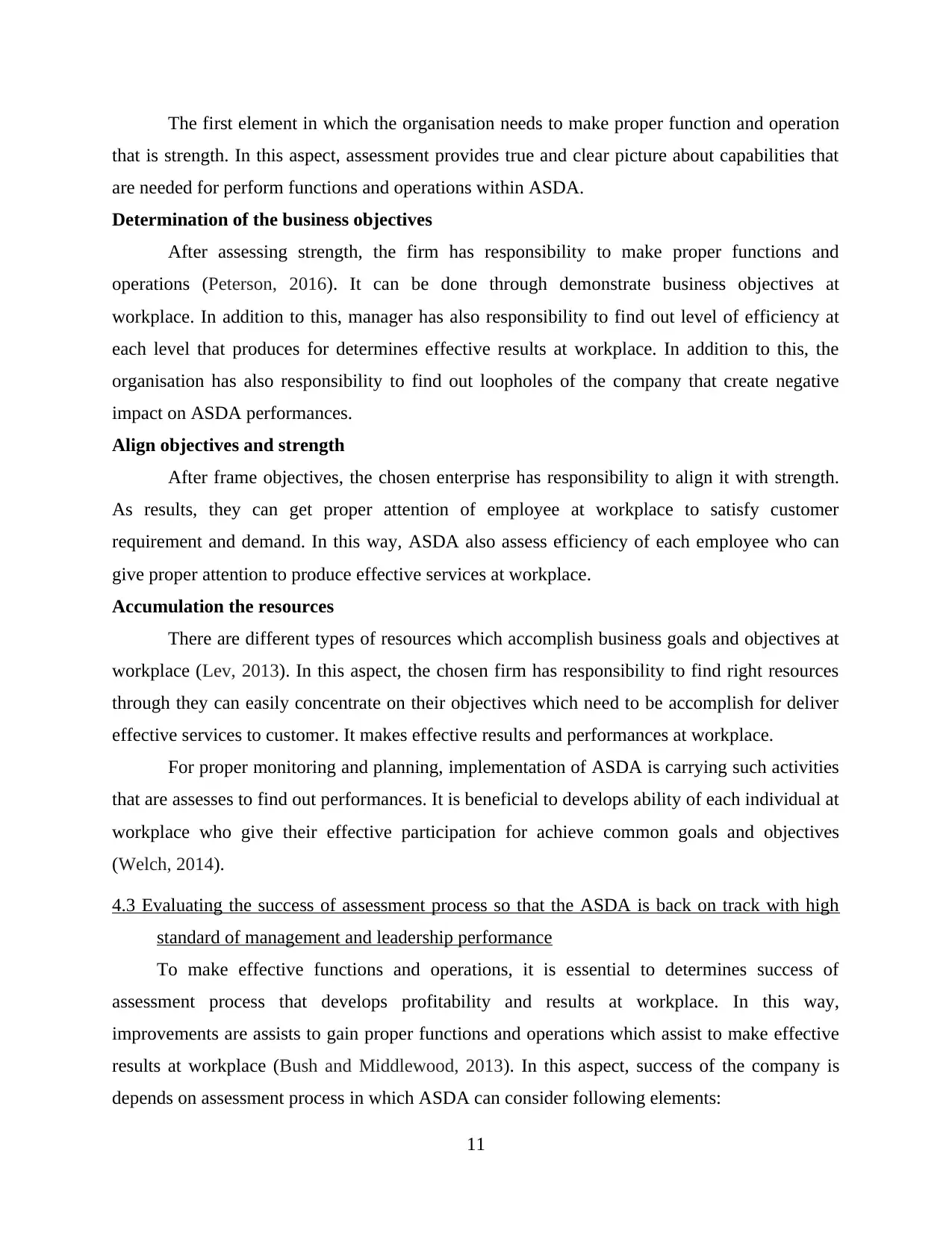
The first element in which the organisation needs to make proper function and operation
that is strength. In this aspect, assessment provides true and clear picture about capabilities that
are needed for perform functions and operations within ASDA.
Determination of the business objectives
After assessing strength, the firm has responsibility to make proper functions and
operations (Peterson, 2016). It can be done through demonstrate business objectives at
workplace. In addition to this, manager has also responsibility to find out level of efficiency at
each level that produces for determines effective results at workplace. In addition to this, the
organisation has also responsibility to find out loopholes of the company that create negative
impact on ASDA performances.
Align objectives and strength
After frame objectives, the chosen enterprise has responsibility to align it with strength.
As results, they can get proper attention of employee at workplace to satisfy customer
requirement and demand. In this way, ASDA also assess efficiency of each employee who can
give proper attention to produce effective services at workplace.
Accumulation the resources
There are different types of resources which accomplish business goals and objectives at
workplace (Lev, 2013). In this aspect, the chosen firm has responsibility to find right resources
through they can easily concentrate on their objectives which need to be accomplish for deliver
effective services to customer. It makes effective results and performances at workplace.
For proper monitoring and planning, implementation of ASDA is carrying such activities
that are assesses to find out performances. It is beneficial to develops ability of each individual at
workplace who give their effective participation for achieve common goals and objectives
(Welch, 2014).
4.3 Evaluating the success of assessment process so that the ASDA is back on track with high
standard of management and leadership performance
To make effective functions and operations, it is essential to determines success of
assessment process that develops profitability and results at workplace. In this way,
improvements are assists to gain proper functions and operations which assist to make effective
results at workplace (Bush and Middlewood, 2013). In this aspect, success of the company is
depends on assessment process in which ASDA can consider following elements:
11
that is strength. In this aspect, assessment provides true and clear picture about capabilities that
are needed for perform functions and operations within ASDA.
Determination of the business objectives
After assessing strength, the firm has responsibility to make proper functions and
operations (Peterson, 2016). It can be done through demonstrate business objectives at
workplace. In addition to this, manager has also responsibility to find out level of efficiency at
each level that produces for determines effective results at workplace. In addition to this, the
organisation has also responsibility to find out loopholes of the company that create negative
impact on ASDA performances.
Align objectives and strength
After frame objectives, the chosen enterprise has responsibility to align it with strength.
As results, they can get proper attention of employee at workplace to satisfy customer
requirement and demand. In this way, ASDA also assess efficiency of each employee who can
give proper attention to produce effective services at workplace.
Accumulation the resources
There are different types of resources which accomplish business goals and objectives at
workplace (Lev, 2013). In this aspect, the chosen firm has responsibility to find right resources
through they can easily concentrate on their objectives which need to be accomplish for deliver
effective services to customer. It makes effective results and performances at workplace.
For proper monitoring and planning, implementation of ASDA is carrying such activities
that are assesses to find out performances. It is beneficial to develops ability of each individual at
workplace who give their effective participation for achieve common goals and objectives
(Welch, 2014).
4.3 Evaluating the success of assessment process so that the ASDA is back on track with high
standard of management and leadership performance
To make effective functions and operations, it is essential to determines success of
assessment process that develops profitability and results at workplace. In this way,
improvements are assists to gain proper functions and operations which assist to make effective
results at workplace (Bush and Middlewood, 2013). In this aspect, success of the company is
depends on assessment process in which ASDA can consider following elements:
11
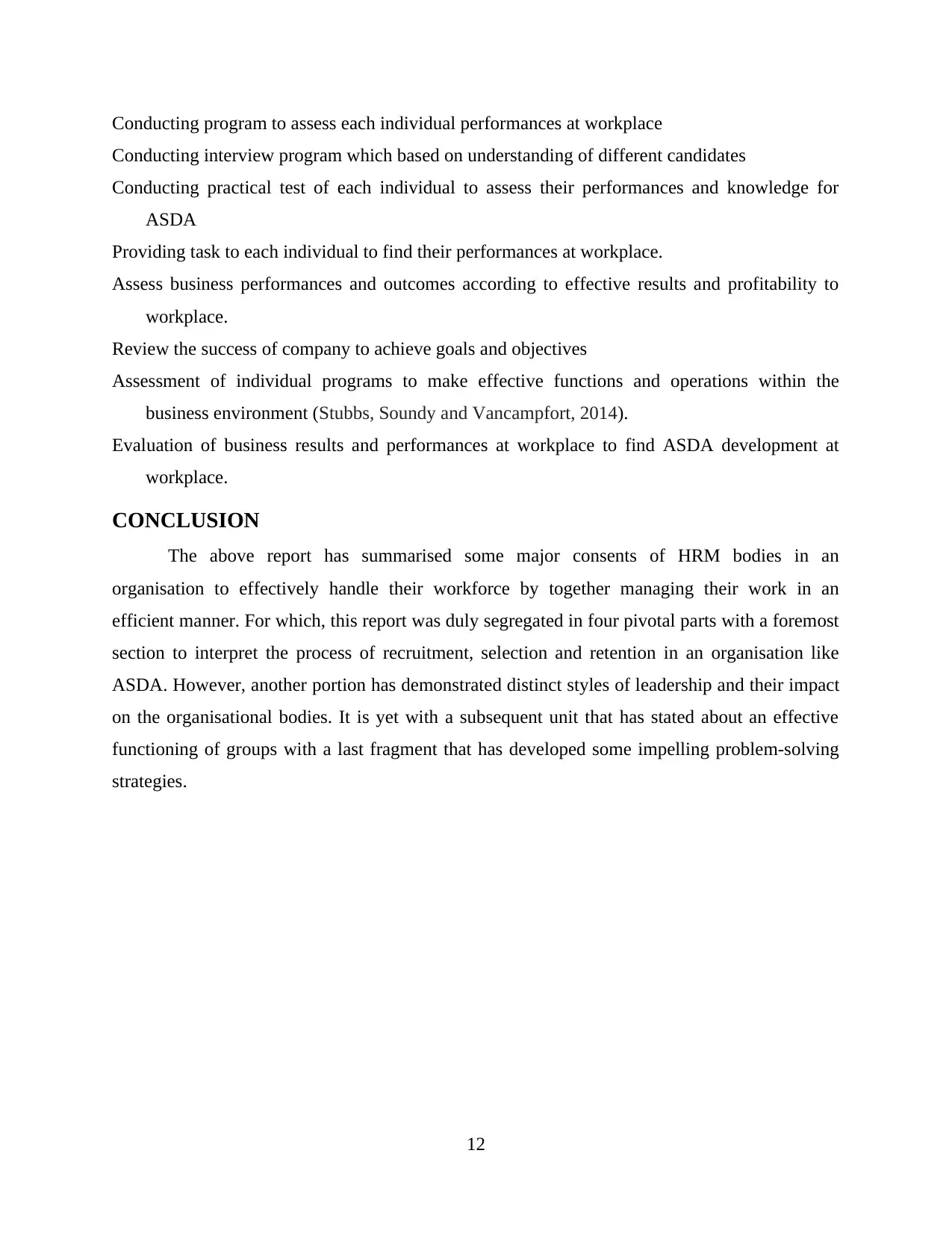
Conducting program to assess each individual performances at workplace
Conducting interview program which based on understanding of different candidates
Conducting practical test of each individual to assess their performances and knowledge for
ASDA
Providing task to each individual to find their performances at workplace.
Assess business performances and outcomes according to effective results and profitability to
workplace.
Review the success of company to achieve goals and objectives
Assessment of individual programs to make effective functions and operations within the
business environment (Stubbs, Soundy and Vancampfort, 2014).
Evaluation of business results and performances at workplace to find ASDA development at
workplace.
CONCLUSION
The above report has summarised some major consents of HRM bodies in an
organisation to effectively handle their workforce by together managing their work in an
efficient manner. For which, this report was duly segregated in four pivotal parts with a foremost
section to interpret the process of recruitment, selection and retention in an organisation like
ASDA. However, another portion has demonstrated distinct styles of leadership and their impact
on the organisational bodies. It is yet with a subsequent unit that has stated about an effective
functioning of groups with a last fragment that has developed some impelling problem-solving
strategies.
12
Conducting interview program which based on understanding of different candidates
Conducting practical test of each individual to assess their performances and knowledge for
ASDA
Providing task to each individual to find their performances at workplace.
Assess business performances and outcomes according to effective results and profitability to
workplace.
Review the success of company to achieve goals and objectives
Assessment of individual programs to make effective functions and operations within the
business environment (Stubbs, Soundy and Vancampfort, 2014).
Evaluation of business results and performances at workplace to find ASDA development at
workplace.
CONCLUSION
The above report has summarised some major consents of HRM bodies in an
organisation to effectively handle their workforce by together managing their work in an
efficient manner. For which, this report was duly segregated in four pivotal parts with a foremost
section to interpret the process of recruitment, selection and retention in an organisation like
ASDA. However, another portion has demonstrated distinct styles of leadership and their impact
on the organisational bodies. It is yet with a subsequent unit that has stated about an effective
functioning of groups with a last fragment that has developed some impelling problem-solving
strategies.
12
⊘ This is a preview!⊘
Do you want full access?
Subscribe today to unlock all pages.

Trusted by 1+ million students worldwide
1 out of 14
Related Documents
Your All-in-One AI-Powered Toolkit for Academic Success.
+13062052269
info@desklib.com
Available 24*7 on WhatsApp / Email
![[object Object]](/_next/static/media/star-bottom.7253800d.svg)
Unlock your academic potential
Copyright © 2020–2025 A2Z Services. All Rights Reserved. Developed and managed by ZUCOL.





